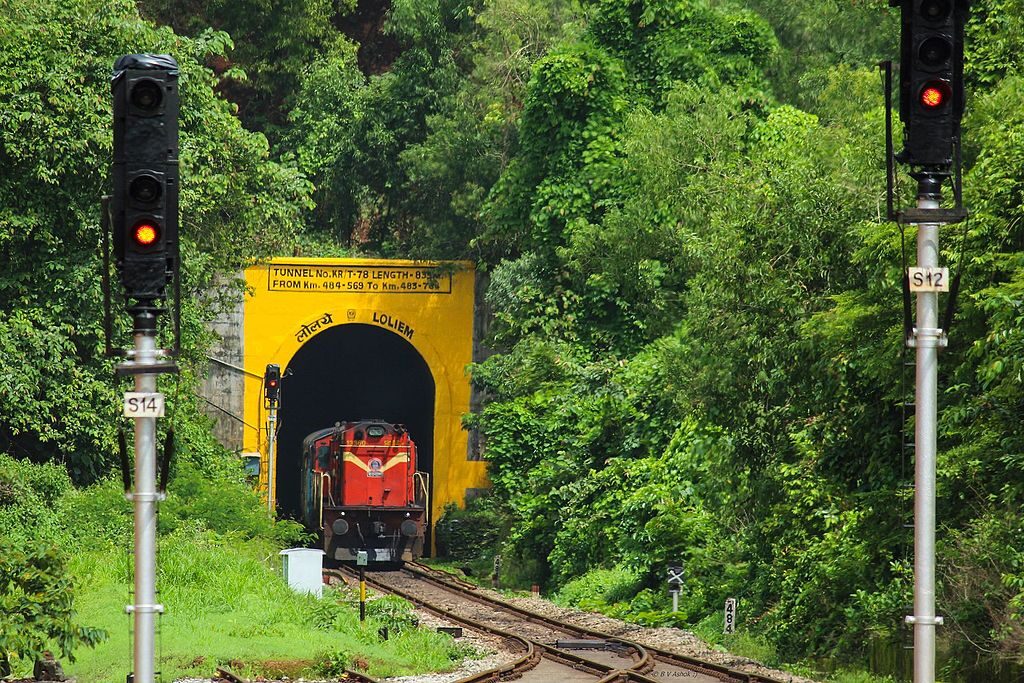Konkan Railways Impacted Agricultural Lands More Than Forest Cover
Jan 7, 2024 | Pratirodh Bureau
Railway projects are exempt from Environmental Impact Assessments and the long-term impacts are not well studied (Photo by Belur Ashok/Wikimedia Commons)
A new study evaluating the impacts of the 740-kilometre long Konkan Railway line has thrown up some surprising results related to the impact on forests. Launched in 1993, the railway line’s route was contentious because it cut through wetlands, forest and other environmentally sensitive areas. But according to the study, forest cover has remained relatively unchanged in the decades since the line came up.
Forest cover is a narrow indicator of an ecosystem’s health. However, the study is among the first to look at the long-term land use change resulting from the entire breadth of the Konkan Railway, including changes to forest cover.
“One of the major motivations to conduct this study was to look how the railway line changed the economy and land use cover in the vicinity of the project. Some reports have said developmental activity in the Western Ghats can disturb the ecology of the region, but at the same time, there’s an urgent need for sustainable development,” Aniket Navalkar, a researcher at the Indian Institute of Technology Bombay and lead author of the study, told Mongabay-India. “Our study offers insights into how land use is affected by linear transport infrastructure like railway over a time-period, and how environmental measures can help compensate for initial losses in forest cover.”

The Konkan Railway stretches across Maharashtra, Goa, Karnataka and Kerala. In 1992, the Goa Foundation, an environmental advocacy group, petitioned against the railway line’s alignment through Goa, arguing it would destroy the state’s unique khazan lands – a type of coastal wetland used for agriculture, aquaculture and salt panning. The Bombay High Court dismissed the petition, saying environmental laws couldn’t bind the construction of the railway line. The Railway now ferries an average of 27 million passengers a year and is considered a lifeline for the southern west coast.
Land Use Changes Over Time
The study examines the land use change that occurred within up to 30 kilometres of the railway line, focussing on four types of land – agricultural, forest cover, water bodies and open spaces and built up land. Open spaces include dry salt flats, beaches, bare exposed rock, strip mines, quarries, gravel pits, and mixed barren land. Built up spaces include residential, commercial, industrial, transportation, and mixed urban land. Water bodies included streams and canals, lakes, reservoirs, bays and estuaries.
The construction of railways is exempt from the environmental clearance process, which means that unlike most large development projects, railway corporations don’t need to conduct Environmental Impact Assessments before construction begins. Under the Forest (Conservation) Act, project developers are obligated to carry out compensatory afforestation for trees felled due to the project. The exemption from the environment clearance process, however, means that information about the long-term impacts of railway projects on the environment and land-use is not well studied or known.
The researchers used satellite data and a “difference-in-difference” (DID) analysis to examine land use change in 59,444 square kilometres along the railway line. A DID analysis provides a comparison between areas that received an intervention and those that didn’t, across the long term.
Between 1991 and 2014 – the study’s assessment years – agricultural land saw the sharpest decline of 21.4 percentage points compared to the comparison region at 20 kilometers from the railway line, and 22.9 percentage points at 30 kilometres from the railway line, in 2008.
Surprisingly, forest cover and water bodies remain relatively unchanged across the study area. To compensate for forest loss during the construction phase of the railway line, the Konkan Railway Corporation Limited (KRCL) planted lakhs of plants and saplings of species like bougainvillaea, acacia, catechu, teak, badam, cashew and gulmohar, among others, which may explain why forest cover was not adversely affected. “Even though initial disturbances happen as a result of engineering interventions, regeneration is possible through afforestation and environmental management as was carried out by the KRCL. This finding is important with regard to railways’ role in sustainable development in developing regions,” the study states.
“What needs to be studied further is whether ecosystems have been affected by the railway line. That is something we have not been able to determine through our study,” Navalkar told Mongabay-India.

According to B.K. Singh, former Principal Chief Conservator of Forests in Karnataka, the replacement of natural forest cover with plantations is likely to have impacts on biodiversity. “There are some 300 odd species in those areas. What was lost was prime, natural forests and the plantations cannot replace that richness in biodiversity. Rivers like the Payaswini have become seasonal and dry up sooner because of forest loss,” he said.
A related study on the socio-economic impacts of the Konkan Railway line suggests it has facilitated the out-migration of male family members for better economic opportunities. Between 1991 and 2014, agricultural land underwent the most dramatic change, reducing by a significant proportion due to the railway line. The railway line also led to an increase in built up area and open spaces. “The plausible explanation for the same may be urbanization along the Konkan Railway line, occupational shifts, and a decline in agricultural labour,” says the study.
The study also found that the railway line aided labour migration to more prosperous regions, and that in doing so “encouraged diversification of economic activities and of workplaces by making it easier to access employment opportunities via daily commutes between rural and urban areas.”
(Published under Creative Commons from Mongabay-India. Read the original article here)
